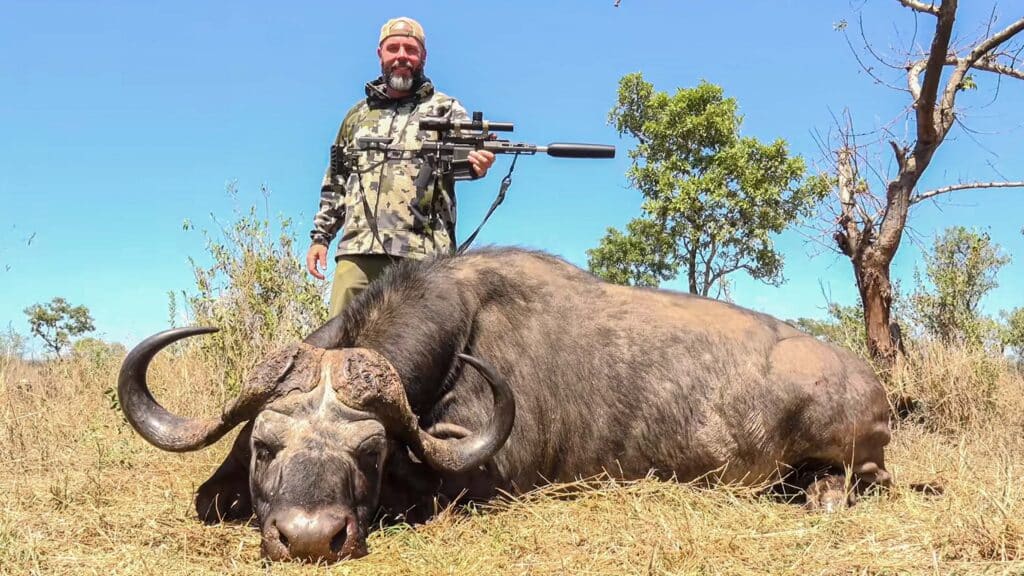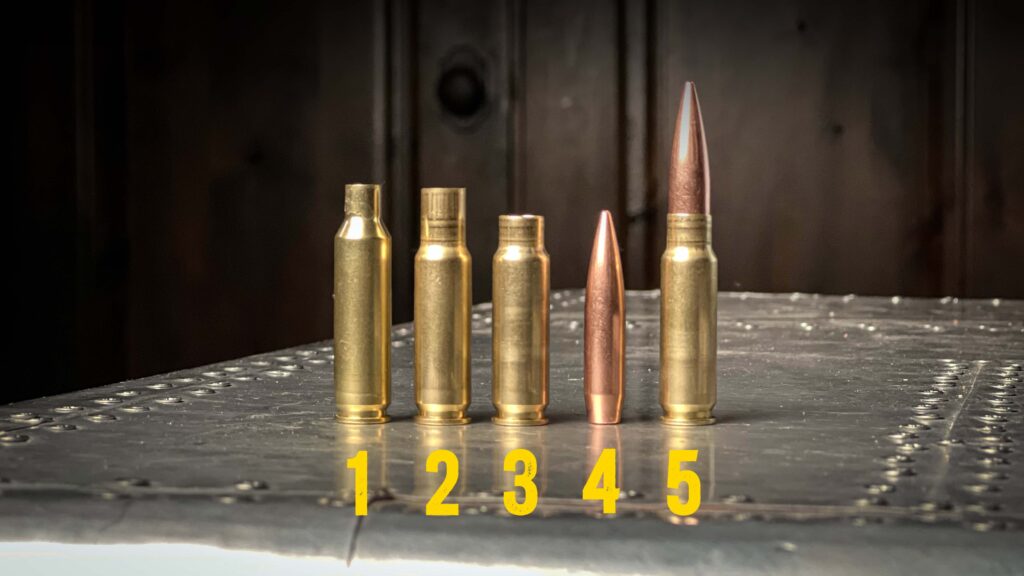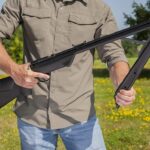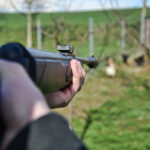When considering the 8.6 Blackout, the wrong question to ask is “Is it better than what we already have?” The right question to ask is “Is this the coolest cartridge design on the market?” The answer to the first question is “only for specific use cases.” The answer to the second question is, unquestionably, “YES!”
In essence, 8.6 Blackout is designed to shoot heavy .338 caliber bullets at modest supersonic or quiet subsonic speeds for hunting or self defense. The cartridge is unique for its radical 1:3 twist rate which produces extreme rotational energy to aid its terminal performance and allows it to shoot accurately with subsonic ammunition. The design allows for shorter barrels and subsonic ammunition to be used.
Despite its uniqueness, the western hunter will struggle mightily to understand the 8.6 Blackout after seeing the following table.
If you value flat-shooting traditional hunting rounds, then the above table would end your interest in 8.6 Blackout. Then, you see photos like one below, and you say. Wait, what? That guy killed a CAPE BUFFALO with a semi-auto rifle with a tiny 12-inch barrel? Suddenly, any hunter’s interest is piqued.

There are many advantages of the 8.6 Blackout which have never been possible with existing cartridge designs, but they only make sense if you’re willing to take a non-traditional look at what a hunting rifle could become.
Table of Contents
Pros and Cons of 8.6 Blackout
Case Design

1 – A typical 6.5 Creedmoor case is the parent case for the 8.6 Blackout
2 – Put a 6.5 Creedmoor case in an 8.6 Blackout reloading die, and drop the press. You end up with a much expanded neck to fit the large bullet, and a shoulder pushed quite a bit lower
3 – Trim the case from step 2, and you have a fully prepared 8.6 Blackout case (that might require some neck turning)
4 – Grab a gigantic bullet to put in your 8.6 Blackout. Notice that this Sierra 225 MatchKing bullet is even longer than the case
5 – A completed 8.6 Blackout cartridge
Comparing 8.6 Blackout to Similar Cartridges

Not surprisingly, the most comparable cartridge to the 8.6 Blackout is its little sister-the .300 Blackout. The .300 Blackout is essentially a .223 case necked up for a giant bullet that allows the cartridge to shoot supersonic or subsonic with heavy-weight penetration.
The 8.6 Blackout essentially accomplishes a similar purpose, but in a much more powerful platform.
Rifles Available in 8.6 Blackout
So far, only three companies produce rifles in the 8.6 Blackout cartridge: Q, Faxon, and Gorilla.
Most people looking to get an 8.6 Blackout rifle will likely end up looking at Faxon Firearms. They make relatively inexpensive barrels for the AR-10 platform (commissions earned). If you already have an AR-10, you can simply screw on one of their barrels and you’re done.
For complete rifles, Faxon has two options: their bolt-action Overwatch, and the AR-10 Sentinel. I personally have their Sentinel AR-10 rifle, and I can confidently say it’s the nicest AR-10 I’ve ever owned.
Q makes high-end rifles with the “cool factor.” They have produced some very innovative suppressors, rifles like “The Fix” and now a cartridge. Looking through their website, the only model I could currently see being produced in 8.6 Blackout is The Fix as a 12″ SBR (meaning you’ll need a tax stamp and enough patience to wait for the ATF).
Gorilla Ammo also produces complete firearms. They have their GF10 Lightweight Hunting Rifle as well as their GF Bolt Action Rifle available in very limited quantities.
Prediction: Will 8.6 Blackout Take Off?
I see 8.6 Blackout is a boutique cartridge.
As a hunting cartridge, it isn’t flat shooting enough to whet the appetite of western hunters. They want cartridges like the new 7mm PRC. Eastern hunters shooting whitetail aren’t exactly clamoring for more power to kill a whitetail. They want cartridges like the 6.5 Creedmoor, or even a lever action 30-30. It frankly isn’t that hard to kill a whitetail at short range. Midwest Hunters are looking to straight-wall cartridges to follow strict state laws.
There is, however, one huge factor that may help to push 8.6 Blackout. It’s the Hornady factor. Hornady manufactures a giant amount of 6.5 Creedmoor ammunition and has worked with Q to produce brass for early production. When Hornady sorts through its backlog, I would expect them to begin producing 8.6 Blackout since they already do production runs for 6.5 Creedmoor brass, and I doubt they’ll miss an opportunity to play with a cartridge that opens up a completely new engineering need for unique bullet designs.
If the last 20 years teaches us anything, it’s that if Hornady touches a cartridge, it’s probably going to take off.
Reloading 8.6 Blackout
Since I had a bucket of 6.5 Creedmoor brass, I chose to convert that brass to 8.6 Blackout rather than waiting for brass to become available. I’m glad I didn’t wait, because it ended up being a rather enjoyable process.
I was informed by others online that Hornady 6.5 Creedmoor brass was the best option for converting, so I blindly obeyed like a sheep.
I used the Lyman dies in 8.6 Blackout which were very inexpensive. I tried other Lyman dies before that I didn’t like, but this one worked out perfectly.
I kept the expander ball in the die and went down slowly into the case, backing off and coming back down every few millimeters since it is quite a stretch from 6.5mm to 8.6mm. It would have been much better to use an expander mandrel and slowly step up each caliber to 8.6mm, but I wasn’t reloading for precision and wanted quicker results.
The brass looked pretty good at this point. The brass around the shoulder had tiny waves, but it was minimal enough for me not to be concerned.
This left a large neck on the case, which I simply ran through my Frankford Arsenal Case Trim and Prep Center to shave down. I used a trim to length of 1.675″ given that the specified case length was 1.685.” I wish there were more detailed reloading data available, but that was my best estimate for a good “trim to” length. Please, however, don’t rely on my data because I’m a layman and not a ballistician.
The next issue is the neck thickness. Unfortunately, my first batch of ammo produced too thick of a neck, so it wouldn’t fully chamber. I highly recommend the Sheridan case gauge checker for 8.6 Blackout, which was recommended to me originally on the AP2020 Youtube channel.
Next, I loaded the case with Accurate 1680 powder, which was a new powder for me. It’s extremely fine-so fine that I found it very difficult to meter and pour because the fine powder would stick in my funnel no matter what I tried.
I followed the load recommendations from Q which are published on the Faxon website. They are included below.
When doing load development, only use information from the powder or firearms manufacturer-not random blogs like this one. Always start load development low when working with supersonic rounds and work up, or vice-versa for subsonic rounds. Do not use this information for developing loads. It is for academic purposes only and may contain errors.











































